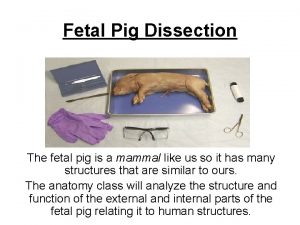CLINICAL SIGNS OF SWINE FEVER Clinical Signs The


- Slides: 2

CLINICAL SIGNS OF SWINE FEVER Clinical Signs: The clinical signs of Classical and African Swine Fever are indistinguishable Acute: • Pigs may die after a short febrile illness and before other clinical signs develop • Pigs become depressed, recumbent, have difficulty breathing, stop eating, and huddle together • Fever (41°C), cyanotic skin haemorrhages (especially at extremities), conjunctivitis, anorexia, ataxia, paresis, convulsions, sometimes vomiting, diarrhoea or constipation • Death usually occurs within 5 -15 days after clinical signs develop. • Mortality depends on the virulence of strain and age of the animal, with young animals being more vulnerable than adults Chronic: • Initial signs are similar to acute infection and progress to non-specific signs (intermittent fever, chronic enteritis, wasting) • Skin haemorrhages are absent • Death after several months of disease (virus is constantly shed) Congenital: • Abortion, resorption, mummification, and stillbirth of piglets • Surviving piglets may be clinically normal at birth but are consistently viraemic and shed the virus until death • Weakness, tremor and poor growth sometimes leading to death P. I. A. D. C Huddling and cyanotic haemorrhages of ears P. I. A. D. C VLA Skin haemorrhages P. I. A. D. C Ataxia and diarrhoea Abortion and mummified foetuses Photos courtesy of: Plum Island Animal Disease Centre, Veterinary Laboratories Agency, Weybridge and Center for Food Security and Public Health at Iowa State University, College of Veterinary Medicine Department of Agriculture, Food and the Marine (March 2014)

POST MORTEM SIGNS OF SWINE FEVER Pathological Findings Acute: • No lesions if death occurs soon after infection • Enlarged and haemorrhagic lymph nodes • Necrotic foci in the tonsils (CSF) • Encephalomyelitis (CSF) • Multi-focal infarctions along the margin of the spleen (CSF) • Enlarged haemorrhagic and friable spleen (ASF) • Widespread haemorrhage in skin, lymph nodes, larynx, bladder, kidney, ileocaecal junction Chronic: • Button ulcers in caecum and large intestines (CSF) • Generalized depletion of lymph tissue • Haemorrhagic lesions often absent CFSPH Haemorrhages in the tonsils Haemorrhages in the lymph nodes CFSPH Infarcts in the spleen (CSF) P. I. A. D. C Haemorrhages in the kidney Enlarged haemorrhagic spleen (ASF) Differential Diagnosis The following diseases have similar gross pathology and laboratory differential diagnosis is essential: • Porcine Dermatitis Nephropathy Syndrome, Post-weaning Multisystemic Wasting Syndrome • Bovine Viral Diarrhoea, Aujeszky’s Disease, Porcine Reproductive and Respiratory Syndrome Bacterial diseases (e. g. erysipelas, salmonellosis, pasteurellosis) usually respond to antimicrobials and have lower morbidity and mortality rates. Photos courtesy of: Plum Island Animal Disease Centre, VLA Weybridge and Center for Food Security and Public Health at Iowa State University, College of Veterinary Medicine Department of Agriculture, Food and the Marine (February 2014)



